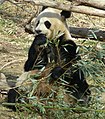Faịlụ:Giant Panda Washington DC.JPG
Ọdịdị

Otu nyochaa a ha:527 × 600 piksels Ndị ọzọ mkpebi:211 × 240 piksels | 422 × 480 piksels | 675 × 768 piksels | 1,174 × 1,336 piksels.
Failụ si na nke mbu (1,174 × 1,336 pixel, ívù akwukwo orunótu: 765 KB, MIME nke: image/jpeg)
Ịta nke usòrò
Bìri èhì/ogè k'ị hụ òtù ụ̀fa dị̀ m̀gbè ahụ̀.
| Èhì/Ogè | Mbọ-aka | Ógólógó na asaá | Òjìème | Nkwute | |
|---|---|---|---|---|---|
| dị ùgbu â | 06:48, 7 Febụwarị 2008 |  | 1,174 × 1,336 (765 KB) | Mattflaschen | {{Information |Description={{en|Taken at the en:National Zoo in en:Washington, D.C. The giant panda (Ailuropoda melanoleuca, "black-and-white cat-foot"; Chinese: 大熊貓, Hanyu Pinyin: Dàxióngmāo) is a mammal classified in the bear family, |
Ojiji faịlụ
Ihe ndị na-eso ihe eji Ihu akwụkwọ eme na faịlụ a:
Ejiji failụ zụrụ ọha
Wikis ndi a edeputara na eji kwa failụ a:
- Ihe eji na bbc.wikipedia.org
- Ihe eji na en.wikipedia.org
- Ihe eji na hy.wikipedia.org
- Ihe eji na id.wikipedia.org
- Ihe eji na io.wikipedia.org
- Ihe eji na is.wikipedia.org
- Ihe eji na it.wikipedia.org
- Ihe eji na sc.wikipedia.org
- Ihe eji na ta.wikipedia.org
- Ihe eji na uz.wikipedia.org
- Ihe eji na vi.wikipedia.org
